

Sears List. Frontmatter:View Table of Contents | Preface | A History of the Sears List | Principles of the Sears ListHeadings:Headings to be Added by the Cataloger | "Key" Headings | List of Canceled and Replaced HeadingsSubdivisions:The Use of Subdivisions in the Sears List | List of Subdivisions Provided for in the Sears ListSearch:Search the Sears List of Subject Headings Certain principles and practices of subject cataloging should be understood before an attempt is made to assign subject headings to library materials.
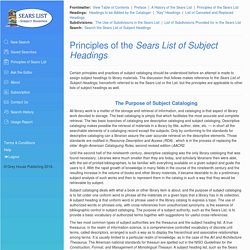
SearsFM. Order in the library game. Shelve-it Full Screen. Library Organization - The Library Ninja. Spine label for nonfiction.

Our library uses the Dewey Decimal System to organize many of our books. Melvil Dewey created this system a long time ago. Fun Fact: We have the everyone readers and fiction books in separate sections, though they could also be put in the Dewey Decimal System! The Dewey Decimal System is a little bit tricky until you get the hang of it. Books are in order by the number first, and then alphabetically by the author's last name after that. Dewey Decimal Call Numbers - How to Read Call Numbers - LibGuides at Washington State University. DDC 23 Summaries. What are call numbers for? What do they mean? - Library FAQ & Virtual Reference. Find Materials in the Main Stacks – Using Library Spaces – U of I Library.
The most current Deck Directory can be found at the entrance to the Main Stacks.
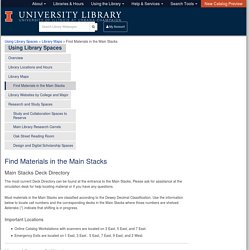
Please ask for assistance at the circulation desk for help locating material or if you have any questions. Most materials in the Main Stacks are classified according to the Dewey Decimal Classification. Use the information below to locate call numbers and the corresponding decks in the Main Stacks where those numbers are shelved. Asterisks (*) indicate that shifting is in progress. Important Locations Online Catalog Workstations with scanners are located on 3 East, 5 East, and 7 East.Emergency Exits are located on 1 East, 3 East , 5 East, 7 East, 9 East, and 2 West. Cataloging Your Books – Information Sciences Virtual Library – U of I Library.
Classify trnee manual. Instructions. Note: You will need a valid Dewey authorization to access the download page.

To install the OCLC Dewey Cutter Program: On the OCLC web site, go to the Dewey Cutter Program page Under Dewey Cutter Software, click Download now. You will be presented with the OCLC Microcomputer Software License Agreement. If you accept the terms of the agreement, proceed by clicking the I accept button at the bottom of the page. When the file download begins, save the cutter110.exe file to a location on your computer.
Definition: Cutter number. Understanding Call Numbers & LC Classification - Browsing the Shelves - Library Guides at UC Berkeley. Sears 19th Edition. Sears 19th Edition. BISAC Subject Headings List, Fiction - Book Industry Study Group. Controlled vocabularies (subjects) For those of you who could not attend today's teleconference, this week's tip will focus on its key takeaway: Types of controlled vocabularies.As you are aware, the Library of Congress Subject Headings index (LCSH) is a ”controlled vocabulary,” that is, a list of authorized words to use in 6xx fields.
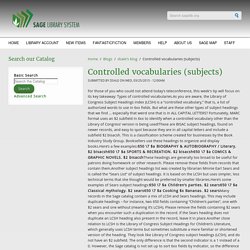
But what are these other types of subject headings that we find … especially that weird one that is in ALL CAPITAL LETTERS? Fortunately, MARC format uses an $2 subfield in 6xx to identify when a controlled vocabulary other than the Library of Congress’ version is being used! These are BISAC subject headings, found on newer records, and easy to spot because they are in all capital letters and include a subfield $2 bisacsh. This is a classification scheme created for businesses by the Book Industry Study Group. Children’s Subject Headings (CSH) List - Children’s and Young Adults’ Cataloging Program (CYAC): Cooperative Programs (Cataloging and Acquisitions, Library of Congress) The Children’s and Young Adult’s Cataloging Program provides cataloging tailored to the needs of children and young adults who use school and public libraries.

The CYAC Program catalogs items by creating bibliographic records complete with Children’s Subject Headings and a brief noncritical summary to offer easier subject access to those materials. CYAC catalogers apply current Library of Congress subject cataloging policies and practices, supplemented by CYAC policies. Ordering Numbers to 20 Worksheet Cut and Stick Best Of Lesson Dewey Decimal System Table Fraction Conversion Chart Tattoo. Please share to download lesson dewey decimal system table fraction conversion chart tattoo from ordering numbers to 20 worksheet cut and stick, image source: tattoodonkey.comAwesome ordering Numbers to 20 Worksheet Cut and Stick Pics - From the thousand photos online concerning ordering numbers to 20 worksheet cut and stick, we selects the very best choices together with ideal resolution simply for you, and now this pictures is usually considered one of photos collections in this best images gallery with regards to Awesome ordering Numbers to 20 Worksheet Cut and Stick Pics.

I hope you might want it. Library Skills - Mrs. Roy's Favorite Links. Dewey Decimal Classification System. 600 Technology (Applied sciences) 601 Philosophy & theory 602 Miscellany 603 Dictionaries & encyclopedias 604 Special topics 604.2 Technical drawing 604.7 Hazardous materials technology 605 Serial publications 606 Organizations 607 Education, research, related topics 608 Invention & patents 609 Historical, areas, persons treatment 610 Medical sciences; Medicine 610.6 Organizations, management, professions 610.7 Education, nursing, related topics 610.9 Historical, geographic, persons treatment 611 Human anatomy, cytology, histology 612 Human physiology 613 Promotion of health 614 Incidence & prevention of disease 615 Pharmacology & therapeutics, prescription drugs 616 Diseases 617 Surgery & related medical specialties.
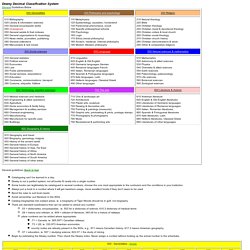
Frequently Asked Reference Questions. The growth of the online public access catalog (OPAC) and sharing among institutions has added variety to the kinds of library call numbers you may encounter.
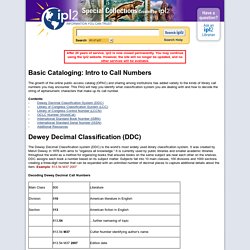
This FAQ will help you identify what classification system you are dealing with and how to decode the string of alphanumeric characters that make up its call number. Contents: - Dewey Decimal Classification System (DDC) - Library of Congress Classification System (LCC) - Library of Congress Control Number (LCCN) - OCLC Number (WorldCat) - International Standard Book Number (ISBN) - International Standard Serial Number (ISSN) - Additional Resources The Dewey Decimal Classification system (DDC) is the world’s most widely used library classification system. It was created by Melvil Dewey in 1876 with aims to “organize all knowledge.”
It is currently used by public libraries and smaller academic libraries throughout the world as a method for organizing books that ensures books on the same subject are near each other on the shelves. Frequently Asked Reference Questions.